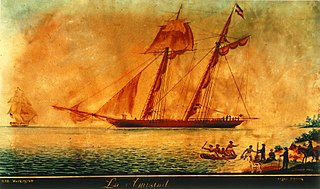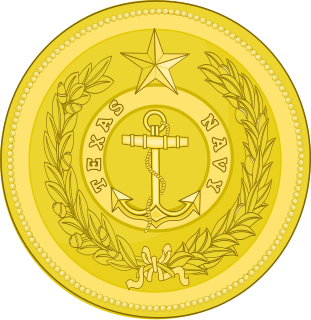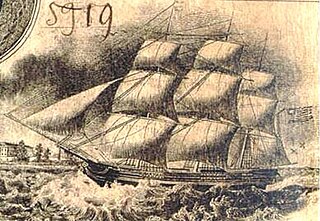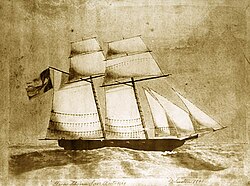
Edwin Ward Moore, was an American naval officer who also served as Commander-in-chief of the Navy of the Republic of Texas.

USS Sciota was a Unadilla-class gunboat built on behalf of the United States Navy for service during the Civil War. She was outfitted as a gunboat, with both a 20-pounder rifle for horizontal firing, and two howitzers for shore bombardment, and assigned to the Union blockade of the waterways of the Confederate States of America.

USS Kennebec was a Unadilla-class gunboat built for the U.S. Navy following the outbreak of the American Civil War. She was named for the Kennebec River.

Washington was a revenue cutter that served in the United States Revenue Cutter Service and in the United States Navy. She discovered, boarded and captured La Amistad after the slaves onboard had seized control of that schooner in an 1839 mutiny.
The second Navy vessel to bear the name Sachem, this screw steamer was built in 1844 at New York City, where it was purchased by the Navy on 20 September 1861.

The Texas Navy, officially the Navy of the Republic of Texas, also known as the Second Texas Navy, was the naval warfare branch of the Texas Military Forces during the Republic of Texas. It descended from the Texian Navy, which was established in November 1835 to fight for independence from Centralist Republic of Mexico in the Texas Revolution. The Texas Navy, Texas Army, and Texas Militia were officially established on September 5, 1836 in Article II of the Constitution of the Republic of Texas. The Texas Navy and Texas Army were merged with the United States Armed Forces on February 19, 1846 after the Republic of Texas became the 28th state of America.

The Texan schooner Brutus was one of the four ships of the First Texas Navy (1836–1838) that during the Texas Revolution wreaked havoc on towns along the coast of Mexico, blockaded Mexican ports, and captured ships bound for Mexico with goods and munitions of war.
The Texas schooner Invincible was one of the four schooners of the Revolutionary Texas Navy (1836-1837). She began her service in January 1836 and immediately began attacking ships supplying the Mexican army in Texas, including capturing the United States merchant vessel Pocket and later the British ship Eliza Russell. Both of these actions caused diplomatic incidents between the Republic of Texas and the United States and the United Kingdom.

The Texas schooner Liberty was one of the four schooners of the First Texas Navy (1836–1838). She served in the Texas Navy for only about 6 months, capturing the Mexican brig Pelicano loaded with weapons for their army in Texas. Later that year, she sailed to New Orleans accompanying the wounded Sam Houston, where she was repaired. Texas was unable to pay for the repairs and the ship was sold in June, 1836, to pay for the cost of the repairs. This left the Texas Navy with only three ships.

The Texan brig Wharton was a two-masted brig of the Second Texas Navy from 1839-1846. She was the sister ship of the Archer. Accompanying the Texas flagship, Austin, she defeated a larger force of Mexican Navy steamships in the Naval Battle of Campeche in May 1843. Transferred to the United States Navy in 1846, she was sold for $55.
USS Penobscot was a Unadilla-class gunboat built for the Union Navy during the American Civil War.

USS Kanawha was a Unadilla-class gunboat built for the Union Navy during the American Civil War. She was used by the navy to patrol navigable waterways of the Confederacy to prevent the South from trading with other countries.

The Texan steamship Zavala was a Texas Navy ship in Texas' second Navy after the Texas Revolution. She was the first steamship-of-war in the Texas Navy.

The Texan sloop-of-war Austin was the flagship of the Second Texas Navy from 1840 to 1846. Commanded by Commodore Edwin Ward Moore, she led a flotilla in the capture of Villahermosa in 1840. After a period of inaction in port, Austin participated in the Naval Battle of Campeche in 1843. Austin was transferred to the United States Navy when Texas joined the United States in 1845, but was run aground and broken up in 1848.

The Naval Battle of Campeche took place on April 30, 1843, and May 16, 1843. The battle featured the most advanced warships of its day, including the Mexican steamer Guadalupe and the equally formidable Moctezuma which engaged a squadron of vessels from the Republic of Yucatan and the Republic of Texas. The latter force consisted of the Texas Navy flagship sloop-of-war Austin, commanded by Commodore Edwin Ward Moore, the brig Wharton, and several schooners and five gunboats from the Republic of Yucatán, commanded by former Texas Navy Captain James D. Boylan. Texas had declared its independence in 1836 but by 1843 Mexico had refused to recognize it. In Yucatán, a similar rebellion had begun and was fought off-and-on from 1836 to 1846. The battle ended in a combined Yucatecan and Texan victory. A scene from this battle is engraved on the cylinder of every Colt 1851 Navy and 1861 Navy revolver.
USS Antona (1863) was a steamer captured by the Union Navy during the American Civil War. She was used by the Union Navy as a dispatch boat and gunboat in support of the Union Navy blockade of the Confederate States of America.

The Texan schooner San Antonio was a two-masted schooner of the Second Texas Navy from 1839-1840. She was the sister ship of the San Jacinto and the San Bernard. In 1840, San Antonio was part of the Texas Navy flotilla led by Commodore Edwin Ward Moore which was dispatched to assist Yucatecan rebels that had taken up arms against Mexico. In February 1842, while re-provisioning in New Orleans, the crew of the San Antonio mutinied and the Lieutenant was killed. This was the only mutiny in the history of the Texas Navy. That fall, the San Antonio sailed for Campeche and was never heard from again.

The Texan schooner San Bernard was a two-masted schooner of the Second Texas Navy from 1839-1840. She was the sister ship of the San Jacinto and the San Antonio. In 1840, San Antonio was part of the Texas Navy flotilla led by Commodore Edwin Ward Moore which was dispatched to assist Yucatecan rebels that had taken up arms against Mexico. Returning to the Yucatan in 1841, San Bernard assisted in the capture of three Mexican prizes. Upon return to Galveston, San Bernard was driven ashore and was not repaired. When Texas joined the United States in 1846, San Bernard was transferred to the United States Navy and then sold for $150.

The Texian Navy, also known as the Revolutionary Navy and First Texas Navy, was the naval warfare branch of the Texian armed forces during the Texas Revolution. It was established by the Consultation of the Republic of Texas on November 25, 1835. Along with the Texian Army, it helped the Republic of Texas win independence from the Centralist Republic of Mexico on May 14, 1836 at the Treaties of Velasco. It was replaced by the Texas Navy on March 23, 1839.

The Texan brig Potomac was a ship of the Second Texas Navy that never sailed as a warship. For a while, in 1838, she was the only ship in the Texas Navy. She was decommissioned in 1843.













